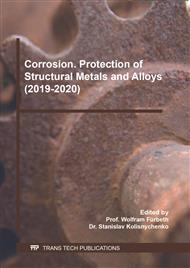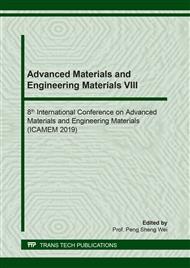p.475
p.481
p.487
p.493
p.499
p.505
p.511
p.517
p.522
Modification of Ligustrum vulgare Leaves Extract as Eco-Friendly Corrosion Inhibitors in Oil Fields
Abstract:
Ligustrum vulgare is an evergreen tree. The leaves are opposite, glossy dark green, 6–17 centimetres (2.4–6.7 in) long and 3–8 centimetres (1.2–3.1 in) broad. The ligustrum vulgare leaves contain two main components, one of which is oleanolic acid and the other is p-hydroxyphenylethanol which indicates its extracts suitable to be used as an effective corrosion inhibitor. Extracts of ligustrum vulgare leaves (PE) were modified with hydroxymethylation reaction (PM1) and Mannich reaction (PM2) to produce the relative stable green acidic corrosion inhibitors. The extracts of ligustrum vulgare leaves have been investigated on the corrosion inhibition of A3 steel with weight loss. The results show that these inhibitors have good corrosion inhibition effect on A3 steel. The PM2 are the most effective for corrosion inhibition, and the inhibition efficiency can reach 75.95%. When the temperature is 60°C, the corrosion inhibition rate of PE, PM1, PM2 is only 24.46%, 42.35% and 39.35% respectively which can not effectively prevent the corrosion of the metal. And the extracts inhibit corrosion mainly by adsorption mechanism. This adsorption accords with Langmuir adsorption isotherm.
Info:
Periodical:
Pages:
499-504
Citation:
Online since:
July 2019
Authors:
Keywords:
Price:
Сopyright:
© 2019 Trans Tech Publications Ltd. All Rights Reserved
Share:
Citation:



